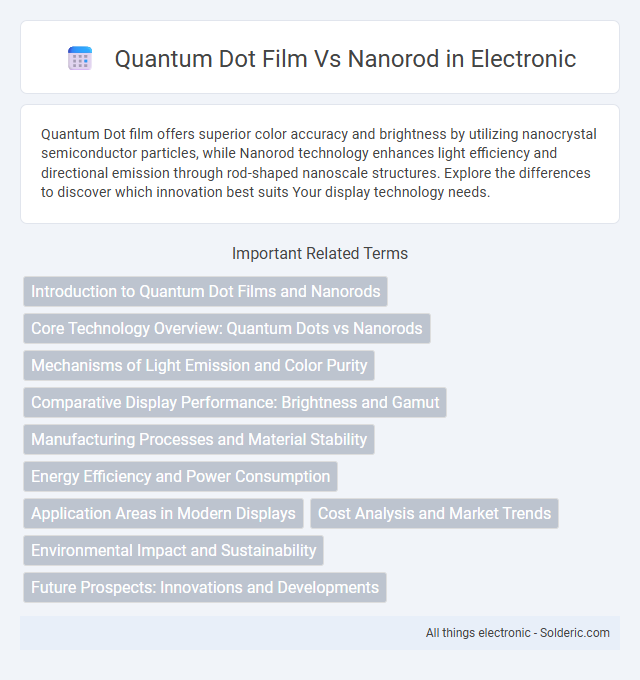Quantum Dot film offers superior color accuracy and brightness by utilizing nanocrystal semiconductor particles, while Nanorod technology enhances light efficiency and directional emission through rod-shaped nanoscale structures. Explore the differences to discover which innovation best suits Your display technology needs.
Comparison Table
| Feature | Quantum Dot Film | Nanorod |
|---|---|---|
| Structure | Spherical semiconductor nanocrystals | Rod-shaped semiconductor nanocrystals |
| Size | 2-10 nm diameter | Length: 10-100 nm, Diameter: 2-5 nm |
| Optical Properties | Size-tunable emission, narrow bandwidth | Polarized emission, anisotropic optical behavior |
| Applications | Displays, solar cells, bio-imaging | Photovoltaics, LEDs, photocatalysis |
| Synthesis | Colloidal synthesis with controlled nucleation | Directed growth along crystal axis |
| Charge Transport | Isotropic charge transport | Enhanced charge mobility along rod axis |
| Stability | Moderate; sensitive to oxidation | Generally higher stability due to shape |
Introduction to Quantum Dot Films and Nanorods
Quantum Dot films consist of nanoscale semiconductor crystals that efficiently convert light into vivid, high-purity colors, enhancing display brightness and color accuracy. Nanorods, unlike spherical quantum dots, offer anisotropic shapes that improve charge transport and light emission directionality, making them ideal for advanced optoelectronic applications. Understanding the distinct properties of Quantum Dot films and Nanorods helps you choose the best technology for superior visual performance and device efficiency.
Core Technology Overview: Quantum Dots vs Nanorods
Quantum Dot films utilize semiconductor nanocrystals that emit light with high color purity and tunable wavelengths due to quantum confinement effects in all three spatial dimensions. Nanorods differ by their anisotropic shape, providing directional light emission and enhanced polarization properties, which improve display brightness and efficiency. Core technology in Quantum Dots focuses on spherical particles for uniform emission, while Nanorods leverage elongated structures for improved optical anisotropy and performance in optoelectronic applications.
Mechanisms of Light Emission and Color Purity
Quantum Dot films emit light through quantum confinement effects, where electrons recombine with holes within nanoscale semiconductor crystals, producing highly pure and tunable colors with narrow emission spectra. Nanorods utilize anisotropic shapes to enhance polarized light emission and improve brightness, but their emission spectra are generally broader than Quantum Dots, leading to slightly lower color purity. The superior color purity of Quantum Dot films results from their size-dependent emission wavelengths and uniform particle distribution, making them ideal for high-performance displays.
Comparative Display Performance: Brightness and Gamut
Quantum Dot film delivers superior brightness and a wider color gamut compared to Nanorod-based displays, enhancing visual clarity and vividness. Your viewing experience benefits from Quantum Dot technology's higher luminous efficiency and more precise color reproduction, which achieves up to 120% NTSC color gamut. Nanorod displays, while innovative, generally offer lower brightness levels and narrower color ranges, making Quantum Dot film the preferred choice for premium display performance.
Manufacturing Processes and Material Stability
Quantum dot films are typically manufactured using solution-based processes such as spin coating or roll-to-roll printing, enabling uniform thin film deposition with high scalability. Nanorods require more complex synthesis techniques like seed-mediated growth or vapor-liquid-solid methods, which often involve precise temperature and chemical control to achieve anisotropic shapes. In terms of material stability, quantum dot films benefit from surface passivation that reduces photo-oxidation and enhances longevity, while nanorods face challenges with shape-dependent degradation and require robust encapsulation to maintain optical properties under operational conditions.
Energy Efficiency and Power Consumption
Quantum Dot films offer superior energy efficiency by converting light into vibrant colors with minimal power loss, making them ideal for high-performance displays. In contrast, Nanorods provide efficient charge transport but often require higher power consumption due to less optimized light emission properties. Your choice between these nanomaterials impacts overall device power consumption and energy savings, with Quantum Dot films generally outperforming Nanorods in energy-efficient applications.
Application Areas in Modern Displays
Quantum Dot films enhance modern displays with superior color accuracy and brightness, making them ideal for televisions, smartphones, and monitors. Nanorod technology excels in flexible and transparent displays due to its unique anisotropic properties, advancing applications in wearable devices and augmented reality. Your choice between Quantum Dot film and Nanorod depends on the specific display requirements, such as rigidity versus flexibility and color performance needs.
Cost Analysis and Market Trends
Quantum Dot films generally offer cost advantages over Nanorod technologies due to lower material and manufacturing expenses, driving wider adoption in consumer electronics and display markets. Market trends indicate a growing preference for Quantum Dot films in large-scale applications such as televisions and monitors, supported by advancements that enhance color accuracy and energy efficiency. Nanorod-based solutions, while offering unique optical properties, face higher production costs and limited scalability, constraining their market penetration primarily to niche scientific and industrial uses.
Environmental Impact and Sustainability
Quantum Dot films typically use heavy metals like cadmium, raising concerns over toxicity and environmental pollution during production and disposal. Nanorod technologies often utilize less toxic materials, offering a more eco-friendly alternative with potentially lower environmental impact. Sustainable manufacturing processes and recyclability of nanorods contribute to their growing preference in green technology applications.
Future Prospects: Innovations and Developments
Quantum Dot film technology is rapidly advancing with enhanced color purity and energy efficiency, making it a prime candidate for next-generation displays and photovoltaics. Nanorod-based materials show promising developments in directional conductivity and tunable optical properties, offering innovative applications in sensors and optoelectronics. Emerging research integrates hybrid Quantum Dot-nanorod systems to maximize performance, scalability, and stability for future nanotechnology devices.
Quantum Dot film vs Nanorod Infographic

 solderic.com
solderic.com